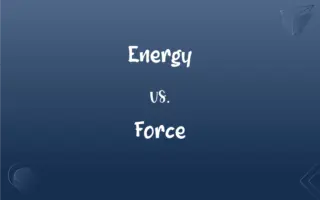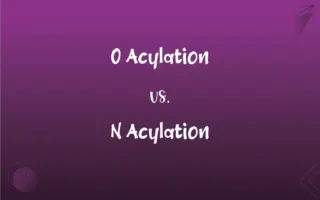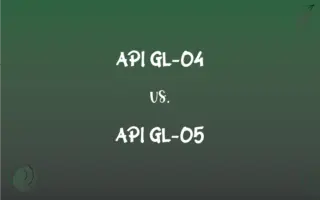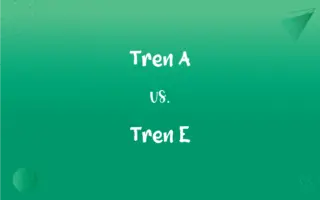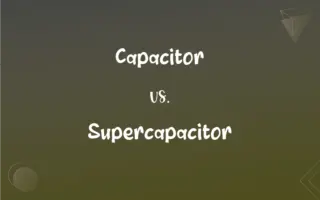Alternating Current vs. Direct Current: What's the Difference?
Edited by Aimie Carlson || By Harlon Moss || Updated on October 16, 2023
Alternating current (AC) periodically changes direction, while direct current (DC) flows consistently in one direction. Both are methods of delivering electrical energy.

Key Differences
Alternating current, commonly known as AC, is a type of electric current where the flow of electric charge periodically reverses direction. It's characterized by its voltage or current changing direction or magnitude cyclically. On the other hand, direct current, referred to as DC, is an electric current flowing in one direction only, maintaining a constant voltage or current.
The most common source of alternating current is the power grid, where electrical energy is distributed to homes and businesses. This type of current is used primarily because it can be easily transformed to different voltages using transformers, making long-distance transmission more efficient. In contrast, direct current is typically found in batteries. Devices like cell phones, laptops, and flashlights, which run on batteries, utilize direct current.
When considering applications, alternating current is used for power distribution due to its versatile nature. Since AC voltage can be transformed easily, it suits a variety of electrical needs, from charging a smartphone to powering an entire house. Direct current, given its unidirectional flow, is essential for devices that need a steady voltage supply. It's used in electronics and in applications where energy storage is crucial.
A significant advantage of alternating current is its ability to be converted easily to different voltages, making it ideal for various applications and efficient for long-distance transmission. Direct current, however, offers a consistent and stable flow of electricity, which is ideal for sensitive electronic devices that require a stable power source.
Comparison Chart
Flow Direction
Changes periodically
Constant one direction
ADVERTISEMENT
Common Source
Power grid
Batteries
Applications
Power distribution, household appliances
Electronics, battery-operated devices
Voltage Conversion
Easily transformed using transformers
Requires converters for voltage changes
Transmission
Efficient for long distances
Less efficient for long distances
Alternating Current and Direct Current Definitions
Alternating Current
It's a type of electric current where voltage or current changes its magnitude and direction cyclically.
The oscillations in an alternating current can be represented by a sine wave.
ADVERTISEMENT
Direct Current
DC is typically sourced from batteries or electronic devices.
When you charge your laptop, it converts the alternating current from the outlet to direct current for the battery.
Alternating Current
AC is suited for transforming into different voltages easily.
The versatility of alternating current allows it to be used in various applications, from lighting homes to charging phones.
Direct Current
Direct current is an electric charge flow in one consistent direction.
Batteries in remote controls supply direct current to the device.
Alternating Current
Alternating current can efficiently be transmitted over long distances.
The ability of alternating current to be stepped up or down in voltage makes it optimal for long-distance transmission.
Direct Current
It's crucial for devices requiring a stable and constant power source.
Sensitive medical equipment relies on direct current for precise operations.
Alternating Current
Alternating current is an electric charge flow that periodically reverses direction.
Many household appliances are designed to run on alternating current from the power grid.
Direct Current
It's a type of electric current that maintains a steady voltage or current without oscillations.
Electronics require direct current to function without disruptions.
Alternating Current
It's the standard form of electricity for power distribution networks.
Cities and towns receive alternating current for their power distribution systems.
Direct Current
Direct current is less efficient for long-distance transmission compared to AC.
Though direct current has its advantages, it's not the primary choice for transmitting power across vast distances.
FAQs
What is alternating current (AC)?
AC is an electric current that periodically reverses direction.
How is AC generated?
AC is typically generated by a device called an alternator, which converts mechanical energy into electrical energy.
What's the main advantage of AC?
One of AC's main advantages is that its voltage can be easily transformed, making long-distance transmission more efficient.
Where is AC commonly used?
AC is the type of electricity delivered by public utility companies to homes and businesses.
Who is credited with promoting AC systems?
Nikola Tesla and George Westinghouse were key figures in promoting AC systems over DC in the late 19th century.
How is the frequency of AC defined?
Frequency refers to the number of cycles per second. In the U.S., the standard frequency is 60 Hz, while in many other countries, it's 50 Hz.
Why isn't DC used for power distribution in homes?
Historically, it was challenging to change DC voltage levels, making long-distance transmission inefficient. However, modern HVDC systems have changed this to some extent.
Can AC power electronic devices?
Yes, but many devices require the AC to be converted to DC first, using a rectifier.
Can DC be stored?
Yes, in batteries. Batteries produce and store electricity as DC.
Is AC dangerous?
All electricity can be dangerous. AC, particularly at high voltages, can cause severe injuries or death.
How does DC compare in safety to AC?
Both can be dangerous. While AC has a "push-pull" effect that can disrupt heart rhythms, DC causes continuous muscular contractions that might prevent a person from letting go.
Why is AC used in power grids?
AC can be transformed easily to different voltages, allowing for efficient transmission over long distances.
What is direct current (DC)?
DC is an electric current that flows in one constant direction.
How is DC generated?
DC can be generated by batteries, solar cells, or by converting AC using a rectifier.
What's the main advantage of DC?
DC is stable and doesn't vary with time, making it ideal for many electronics and battery-operated devices.
Can DC be used for long-distance transmission?
Yes, using high-voltage direct current (HVDC) systems, which can sometimes be more efficient than AC transmission.
Who is credited with pioneering DC systems?
Thomas Edison was a major proponent of DC systems in the early days of electrical power distribution.
What’s the waveform of DC?
DC has a constant voltage across time, represented as a straight horizontal line on a graph.
What’s the waveform of AC?
Typically sinusoidal, but can also be triangular or square depending on the source.
Where is DC commonly used?
DC is used in most electronic devices, such as phones, laptops, and LED lights.
About Author
Written by
Harlon MossHarlon is a seasoned quality moderator and accomplished content writer for Difference Wiki. An alumnus of the prestigious University of California, he earned his degree in Computer Science. Leveraging his academic background, Harlon brings a meticulous and informed perspective to his work, ensuring content accuracy and excellence.
Edited by
Aimie CarlsonAimie Carlson, holding a master's degree in English literature, is a fervent English language enthusiast. She lends her writing talents to Difference Wiki, a prominent website that specializes in comparisons, offering readers insightful analyses that both captivate and inform.









